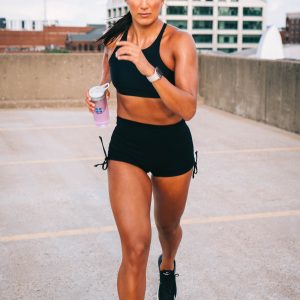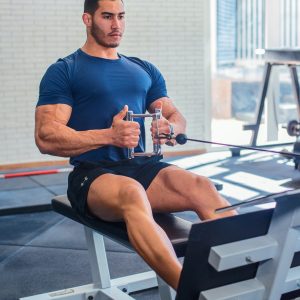They used to call it definition; today we use a different term, body fat percentage. There is an undeniable movement towards ultimate definition these days, at least around show time. After a contest, things change. Most bodybuilders gain 10 pounds after a contest. Most others gain20, 30, or even 40. Usually, this does not manifest itself as roll of fat, but as increased overall size and so-called thicker skin. It would be fair to say that you do yourself no good by gaining more than 10 pounds after a show, and if you start to get rolls of fat, you will be in trouble.
When you reduce your fat percentage to less than 7 percent, your body takes on a whole new appearance. Not only do veins show up in minute detail, but cross-striations of the muscles become apparent, so you’ll look like an anatomy chart, a picture of muscles with the skin stripped away. That’s a condition which has led to a good deal of controversy. With today’s champions, unlike those of yesteryear, the body fat percentage often fluctuates according to the stage of their training. It is not uncommon for a competitive bodybuilder to cut their body fat by two thirds before a contest.
Incidentally, some of the ancient Grecian statues that presumably represented the Greek ideal of male perfection have also been scrutinized with regard to their body fat. The famous Farnese Hercules is estimated to have 11.96 percent, the Apollo Belvedere, 11.76, and Myron’s Discobolus 12.06. If these statues were real men, they would probably not do well in the Olympic contest, where the top six men have averaged a body fat count of fewer than 5 percent.
Why does current fashion seem to be pushing the bodybuilding ideal towards being almost fat-free? One reason is that it enables us to see muscles that we never knew we had. Few physique champions of the distant past could show shapely, delineated serratus muscles and incredibly separate thigh muscles. Today it would be very difficult to win any contest unless all your muscles are diamond sharp. That includes the muscles of the upper thigh and lowers back, two areas from which it is difficult to eliminate all fat. Today, fat free bodies are a must. Maybe styles will once again return to the 11 percentile ideal. Who knows, for the moment, however, low fat and cross-striations are the order of the day.
So how do bodybuilders bring their fat down to a very low percentage? One could give an oversimplified answer: they eat less. True enough, but it goes deeper than that! Most successful body men eat fairly normally when they are not preparing for a contest. That is not to say they eat junk foods. A few do. Most of them don’t, so it is advisable for the food you eat to be as near to its natural state as possible. Foods with natural fibre keep you leaner and fitter than dense calorie foods. Have whole-grain bread, cereals, fruit, vegetables, fish, cheese, organic and white meats, and milk. Stay away from the processed, chemically treated, artificially flavored, brilliantly coloured garbage that your local supermarket offers as food.
Weight training may be unparalleled in its potential for building up the skeletal muscles of body, but is not a particularly good fat burning activity. Aerobic exercise should be included in the program of any bodybuilder interested in staying lean. Typical exercises such as stationary bike riding, road cycling, slow jogging, swimming, and walking, burns calories through prolonged, low intensity effort. Weight training is not aerobic but anaerobic exercise, high-intensity effort which does not result in a steady need for oxygen and considerably stepped-up heart rate.
Aerobic exercise stimulates the production of enzymes that convert fat to energy. The more fat-burning enzymes you have, the better you can use up or burn excess flab. Not only does aerobic activity burn calories better than anything else, it also increases the body’s capacity for burning fat. A long-distance or marathon runner is a veritable fat-burning machine. The reason this is a veritable fat-burning machine. The reason this is so is that the aerobic activity keeps the heart-pulse rate below 80 percent of your maximum. To estimate your maximum heart rate, subtract your age from 220.
Unlike weight training, which can temporarily boost your heart rate to near maximum, walking keeps your heart rate well under 80 percent of your maximum. Needless to say, aerobic exercise should be limited if you are urgently trying to gain weight, and even during regular maintenance training you should not overdo this form of exercise, since it can detract from your bodybuilding gains. Some degree of common sense has to be used so as to balance muscular development with aerobic fitness. If you are fit and well-muscled, you really have a double advantage, extra fat burring enzymes to help you stay lean, and extra muscle mass.










